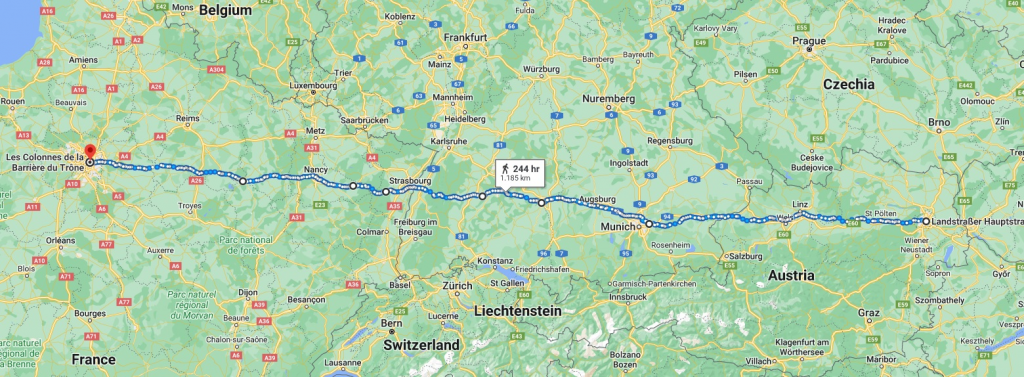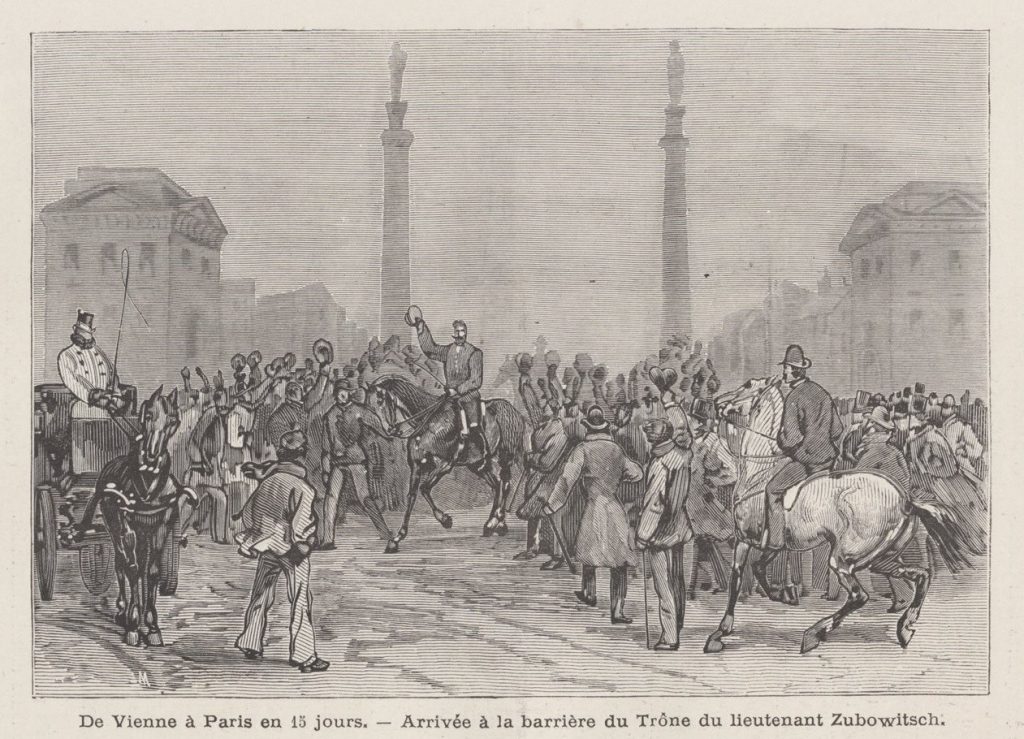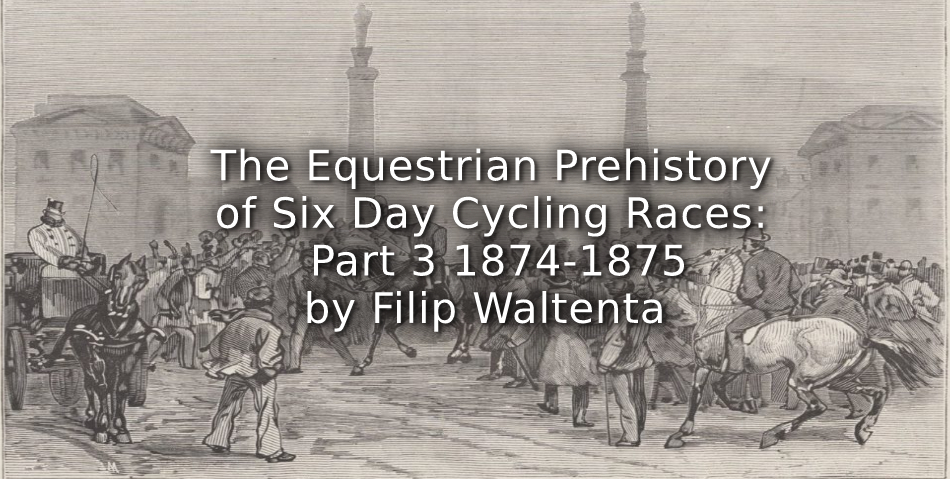To read Part 2 of this series – Click HERE
Introduction
In The Pedestrian Prehistory of Six Day Bicycle Races (Part 1: 1874) and (Part 2: 1875) the emergence of pedestrian six-day races are described in detail.[1][2] 1874 was the year of the emergence of six day pedestrian races in the Northeastern United States. During that year the concept of twenty four-hours and six-day races became the standard of long endurance pedestrianism. In 1875 the time trial concept with only one competitor gradually changed to a race with two or more opponents.
In the mean time on the European mainland the equestrian world would play her proper active part in the emergence and development of the six day racing concept. In addition to the time component of the six-day pedestrian races, this part of the research shows that a major equestrian event has determined the distance component of the first six-day cycling races.
Traffic and mobility between Paris and Vienna
According to an article in the French newspaper Le Temps the journey from Paris to Vienna by carriage on a regular basis was organized from 1780.[3] However, the book L’indicateur Fidèle, ou Guide des Voyageurs by Michel and Desnos already mentions a fixed time schedule in 1765. After leaving Paris on Saturday morning at six o’clock the trip from Paris to Strasbourg took around eleven days. From Strasbourg consecutively the cities of Kehl, Rastatt, Ettlingen, Stuttgart, Ulm, Augsburg, Munich and Linz were crossed to finally arrive in Vienna approximately a week later. The journey was only interrupted at noon for lunch and in the late evening at a post hotel where the travelers could dine and stay overnight. Once arrived in Strasbourg the passengers had to change to another diligence in the direction to Vienna. Unlike the trip Paris-Strasbourg the coach from Strasbourg to Vienna drove day and night, significantly reducing travel time. In Ulm the travelers also had the opportunity to continue their journey by water bus on the Danube which took off every Tuesday.[4]
Fifteen years later, the travel time from Paris to Strasbourg had already been reduced to five days. Every Monday morning at midnight the stagecoach departed in Paris and arrived in Strasbourg on Saturday afternoon.[5] Over the next few decades, traveling with the diligence became more comfortable. The traveling time was shortened significantly as road conditions gradually improved, the diligence became lighter in weight, and better horse breeds were used to pull carriages. By 1850 you could travel daily with the diligence from Paris to Strasbourg or back.[6]

The stagecoach relay from Paris to Strasbourg as a part of the Paris-Vienna trajectory with the stops in the magazine La Diligence.[7]
The Belgian newspaper La Meuse argued that the construction of the whole infrastructure contributed more to the peace keeping process than the Armistice of Villafranca in 1859 between the Second French Empire and the Austrian Empire, and that despite the threat of war both the German states and France were dependant on each other for their own prosperity and safety.[9] Unfortunately ten years later the outbreak of the French-Prussian War proved that they had not read the article in question well.
In 1876 the Belgian civil engineer George Nagelmaekers founded the Compagnie Internationale des Wagons-Lits. Inspired by his trip through the United States with the exquisite Pullman trains he introduced the hotel-on-wheels concept on the European continent. After a first try-out with the luxury Train Éclair a year later on June 5, 1883 the first Express d’Orient train left Paris for Vienna. The latter city remained the terminus of the railway line until October 4, 1883. In 1891 the train was officially renamed the Orient Express.[10]
Mobility and sports challenges
Connecting roads between villages and cities, and the routes for public transport in particular, were often used as a basis for the organization of long-endurance sports challenges. The infrastructure of and along the important traffic arteries was generally a lot better than elsewhere. The roads were in much better condition and the post hotels offered a decent accommodation as a resting place during the day or overnight. Because personal mobility in the eighteen and nineteenth century was limited to travel on foot or horseback, endurance competitions were usually pedestrian or horse races.
In military circles in particular, long-distance horse racing was considered a challenge and an experiment to study the endurance capacity of horse and rider.
From Paris to Vienna on horseback (October 25 till November 9, 1874)
The idea of traveling from Vienna to Paris on one horse arose during a discussion in the Jockey Club of Vienna. Members of the club, among which some hussar officers, were discussing the many crazy stories of the famous and eccentric count Moricz Sandor de Szlavnicza of Hungary, then also known as the Devil’s Horseman. Next to all kind of acrobatics with his horses he also liked to race against a steamboat or to expose them to extreme long distance rides. A Hungarian officer had even claimed that “he had killed enough horses to mount a regiment”.[11]
On one of his stunts during the late eighteen fifties he tried to ride from Vienna to Paris on one horse, but never succeeded as it crashed in Nancy, some three hundred kilometers away from Paris. This story brought the club company to the idea of trying to ride the distance between Vienna and Paris within fifteen days. The wager came to the ear of Mr Baüerle, who put the horses of his stables at the disposal of the rider, the thirty years old lieutenant Theodore Count of Zubowitz. Zubowitz gladly accepted the offer and after a thorough investigation in Baüerle’s stables he chose Caradoc, a seven-year old black mare of English and Hungarian origin.[12] All organizational preparations were made quickly and for the purse of fifty thousand francs the game was on.[13]

The route Paris-Vienna (Source: Google Maps)
On Sunday morning at ten o’clock, October 25, 1874, Count Theodore of Zubowitz and Caradoc started their journey at the cavalry school in the Landstrasse borough in presence of all the officers of his regiment and left Vienna for Paris.[14] The distance between the two capitals was approximately twelve hundred kilometers or six hundred and fifty geographical miles, better known as nautical miles.[15] On his trip from Vienna to Paris Zubowitz crossed the following consecutive cities: Linz, Münich, Augsburg, Ulm, Tübingen, Freudenstadt, Strasbourg, Nancy and Saint-Dizier.
Although the weather conditions were fine for this kind of mission, the journey turned out to be no simple walk in the park. First of all, Zubowitz had broken his right leg twice before and could not move it without wearing an iron brace.[16] On the second day while crossing Enns, a village at twenty kilometer away from Linz, Caradoc got injured on her right leg by stepping on a sharp stone. A similar accident happened on Friday, November 6, in between Freudenstadt and Strasbourg.[17]
During the last seven days Zubowitz had to sleep next to his horse in the stable. He himself only slept three hours a night, leaning up against the wall, keeping an eye on Caradoc. She had to be prevented from laying down (too long), which could lead to digestive problems and diseases.[18] And during a refreshment stop at a hotel in Tournan, a village at fifty kilometer away from Paris, Caradoc got injured by a kick in the thigh from another horse.[19] As a consequence Zubowitz had to postpone the continuation of the trip for a day, jeopardizing the wager.[20]
In addition to the physical issues Caradoc experienced underway, Zubowitz had other problems to face. After the Franco-Prussian War the Alsace and a part of Lorraine were annexed to the newly founded German Empire. The border area had always been a point of discussion between the two superpowers. Not only did it provide the German troops an extra buffer against any French aggression, but the region was also rich in coal, minerals, metal and even oil, while the Rhine was an important traffic artery along the whole Southwestern border of Germany.
And the rest of the Northern parts of France remained occupied from 1871 till the spring of 1874 when the French government had paid their war indemnity of five billion gold francs. In other words, the German troops had only left this region at the beginning of the year.[21]
Traumatized by the brutal German invasion and three years of occupation afterwards, the local population clearly acted very hostile against all German speaking travelers. Zubowitz had crossed Austria and Germany in his hussar uniform, but wisely decided to dress up in a gray civil suit before crossing the French border on the road from Sarrebourg to Lunéville.[22] However, his German accent (some newspapers even mentioned that he did not speak a single word of French) and the road map he constantly used to find his way caught the attention of the revenge-seeking patriots. As Zubowitz drove day and night he put himself into the spotlights and often lost a lot of time at the many checkpoints of the suspicious gendarmerie. In Champigny, where nobody had ever heard about the wager, Zubowitz was even locked up in his hotel room on suspicion of theft and espionage. He could only continue his journey by blowing a padlock and fleeing without paying his expenses.[23]
When he finally reached Vincennes on Monday morning, November 9, he was attended by members of the Union Club of Vienna, the Jockey Clubs of Paris and London, who guided him to the finish line.[24]
Zubowitz arrived in Paris at the Colonnes de la Barrière du Trône at twelve minutes to ten o’clock, where two hundred sympathizers cheered the arrival of the young man, among which several dignitaries of the Austrian embassy, a dozen members of the Jockey Club and a few journalists of the French and Austrian press.[25]
Next to his expenses he had done during the trip count Zubowitz won the sum of ten thousand francs, while the total amount of betting money was estimated at over two hundred thousand pounds.[26]
As usual, the press reacted divided. In several newspapers Zubowitz’s stunt was showered with superlatives. The day after his arrival in Paris, the play Around the World in Eighty Days, based on the book written two years before by the French author Jules Verne, premiered in the famous Porte Saint-Martin theatre. The journey from Vienna to Paris was often compared to the adventure in the book, with Zubowitz in the leading role as Phileas Fogg.[27]
According to other newspapers there was nothing new under the sun. They remembered among others John the Blind, Count of Luxemburg and King of Bohemia who rode with a retinue of eight men in the year 1331 from Prague to Paris in thirteen days in much worse conditions during wintertime.[28]
And also Charles Joseph Lamoral, Prince de Ligne, who lived in Beloeil (Belgium) and worked under the reign of Louis XVI, had even traveled from Vienna to Paris in six days, but of course by using several horses.[29]

Arrival of Lieutenant Zubowitz at the Colonnes de la Barrière du Trône in Paris.[30]
A journalist of the French newspaper l’Evenement ironically remarked that “… if the Minister of War does not put an end to the long distance mania, the whole Austrian army will soon be riding through mountains and valleys”.[32]
And on the day of Zubowitz’s arrival in Paris the Austrian newspaper Die Presse announced the plans of Basile Durilin, a Ukrainian from Dudchany in the district of Cherson, who wanted to make the same journey on a three-horse carriage within thirteen days. Together with a guide, his coachman Sanka and an invited representative of the Vienna Jockey Club the trip was planned at the end of May 1875 but never concretized.[33]
From Pesth to Paris on horseback (May 8 till May 23, 1875)
However, in May 1875 the twenty-seven-year-old Paul Salvi, born in Vienna, decided to break Zubowitz’s record. He was the son of the Italian composer and director of the Vienna opera, Matteo Salvi, and served after his military service as lieutenant in the reserve of the Seventh Hungarian Hussar Regiment.[34][35] As an adventurous dandy during the years 1874-1878 he tried to earn his living with (horse) betting and long-distance riding.[36] Salvi wanted to ride from Budapest to Paris, a trajectory of nearly fifteen hundred kilometers within fifteen days, or nearly three hundred kilometers more than Zubowitz. The trajectory was planned as follows: the start in Pesth (day 1), Babolna (day 2), Sommerein (day 3), Sankt-Pölten (day 4), Hall (day 5), Braunau (day 6), Munich (day 7), Burgau (day 8), Urach (Wurtenberg) (day 9), Oppenau (Bade) (day 10), Fenestrange (day 11), Toul (day 12), Vitry (day 13), Sézanne (day 14), Lagny (day 15), Paris.[37]
On Saturday May 8, 1875, hundreds of curious spectators were gathering in front of the Christinerstädter Arena in Pesth to see Salvi’s departure. At ten o’clock he mounted his horse and left the city for his journey to Paris. Sponsored by Count Emanuel Andrassy he had chosen the seven years old grey dapple Transylvanian stallion Radaman, out of forty horses from the stable of Count Samuel Teleki de Szék in Târgu Mures (Romania).[38]
Despite some minor happenings and very unsettled weather conditions, Salvi and Radaman traveled smoothly through Hungary, Austria and Germany, sometimes at an average speed of ten miles per hour. Unfortunately, on Friday May 21, Salvi’s horse hurt his knee by a nail in a stable during an administrative check of the border authorities at the Moncel’s customs station (near Lunéville).[39]
When he arrived in the late afternoon at the garrison of the Fourth French Hussar Regiment in Bathelémont, Radaman’s injury was examined by the veterinary. And although the horse was still in perfect condition, he told Salvi that Ramadan’s knee was so damaged that he could not continue the race.[40]
The officers and the veterinary stated that without Radaman’s injury, Salvi would have reached Paris very easily within the planned schedule. In an official document, signed by the commander of the Fifth Cavalerie Division general de Montaigu, colonel Bauviaux of the Fourth Hussar Regiment and the mayor of Nancy, was stated that the distance between Pesth and Bathelémont was five miles longer than the distance between Vienna and Paris, and that the distance was covered in just thirteen days and eight hours.[41]
Although he had broken Zubowitz’s distance and time record, Salvi lost in total around fifteen thousand forints on various bets. The total amount of betting money exceeded one hundred thousand forints.[42]
In June 1875, the Vienna Jockey Club had plans to organize a carriage race between the capitals of Austria and France within the span of sixteen days, but as further information is lacking, the event probably never took place.[43]
Conclusion
The first kinds of public transport on land, the post carriage and later the diligence, inspired the equestrian world to organize long-endurance events and sports betting. A race between the capitals of France and Austria, the continental superpowers before the foundation of the German Empire, appealed to the imagination of the equestrian world and was compared to the story of Jules Verne’s book Around the World in Eighty Days.
The six hundred and fifty miles that separate Paris from Vienna, will become important when at a later stadium the velocipede gets involved. The distance component would play a leading role to the emergence of the first six-day cycling race in the autumn of 1875.
Article 2022 @ Filip Walenta
Read Part 4 HERE
References
[1] Walenta, Filip, The Pedestrian Pre-History of Six Day Bicycle Races (Part 1: 1874), Playing Pasts. The Online Magazine for Sport & Leisure History, Februari 21, 2022.
<https://www.playingpasts.co.uk/articles/archival-research/the-pedestrian-prehistory-of-six-day-bicycle-races-part-1-1874/> (Accessed: May 19, 2022).
[2] Walenta, Filip, The Pedestrian Pre-History of Six Day Bicycle Races (Part 2: 1875), Playing Pasts. The Online Magazine for Sport & Leisure History, June 13, 2022.
<https://www.playingpasts.co.uk/articles/archival-research/the-pedestrian-pre-history-of-six-day-bicycle-races-part-2-1875/> (Accessed: August 19, 2022).
[3] Le Temps, June 13, 1873, 2.
[4] Michel, Claude-Sidoine, Desnos, Louis Charles, L’indicateur Fidèle, ou Guide des Voyageurs, qui enseigne toutes les routes royales et particulières de la France (Paris 1765), 13.
[5] Le Temps, June 13, 1873, 2.
[6] La Diligence, Journal des Voyageurs., January 1, 1849, 3.
[7] Ibid., January 1, 1845, 12.
[8] l’Indépendance Belge, October 14, 1859, 1; Journal de Bruxelles, April 14, 1860, 2; Journal de Belgique, July 10, 1860, 1.
[9] La Meuse, August 14, 1860, 2.
[10] Orient-Express, Wikipedia, L’encyclopédie libre.
<https://fr.wikipedia.org/wiki/Orient_Express > (Accessed July 25, 2022).
[11] Ondrejkovics-Sandor de Szlavnicza.
<http://www.ondrejkovics-sandor.com/?lg=2&s=79> (Accessed August 3, 2022)
[12] l’Evénement, November 14, 1874, 2; Ibid, November 23, 1; Le Français, November 11, 1874, 3.
[13] Le Courrier d’Angers, November 12, 1874, 3; Le Soir, November 11, 1874, 3.
[14] Gazette de la Lorraine, October 29, 1874, 1; Le Constitutionnel, November 2, 1874, 3.
[15] 1 nautical mile = 1,852 kilometer
[16] Le Voleur, November 20, 1874, 749-750.
[17] Gazette de la Lorraine, November 8, 1874, 2.
[18] l’Evénement, November 14, 1874, 2.
[19] La France, November 10, 1874, 2.
[20] Le Français, November 11, 1874, 3.
[21] Franco-Prussian War, Wikipedia, The Free Encyclopedia.
<https://en.wikipedia.org/wiki/Franco-Prussian_War> (Accessed on August 7, 2022).
[22] Gazette de la Lorraine, November 8, 1874, 2.
[23] Le Figaro, November 12, 1874, 2; l’Evénement, November 14, 1874, 2.
[24] Le Gaulois, November 10, 1874, 1.
[25] Le Courrier d’Angers, November 12, 1874, 3.
[26] Provinciale Drentsche en Asser Courant, November 16, 1874, 1; The County Observer, November 14, 1874, 6.
[27] Le Petit Journal, November 13, 1874, 1.
[28] Provinciale Noordbrabantsche en ‘s Hertogenbossche Courant, March 11, 1875, 6.
[29] l’Industriel Alsacien, November 13, 1874, 3.
[30] Le Monde Illustré, November 14, 1874, 308.
[31] Le Midi, November 25, 1875, 3.
[32] l’Evénement, November 24, 1874, 2.
[33] l’Avenir Républicain, November 14, 1874, 4; l’Union Nationale, November 14, 1874, 2.
[34] Le Constitutionel, May 24, 1875, 3; Le Figaro, May 16, 1875, 3.
[35] Matteo Salvi, Wikipedia, The Free Encyclopedia.
<https://en.wikipedia.org/wiki/Matteo_Salvi> (Accessed August 10, 2022).
[36] Salvi, Familie, Oesterreichishes Musiklexicon online. <https://www.musiklexikon.ac.at/ml/musik_S/Salvi_Matteo.xml> (Accessed August 12, 2022).
[37] Le Figaro, May 16, 1875, 3.
[38] Ibid, May 11, 1875, 1.
[39] Regensburger Morgenblatt, May 9, 1875, 76; Receuil de Médecine Vétérinaire, 1875, 709-711.
[40] Le Figaro, May 27, 1875, 2.
[41] Journal de Seine-et-Marne, May 30, 1875, 2; Journal de Débats politiques et Littéraires, May 31, 1875, 3.
[42] Affiches de Strasbourg, May 29, 1875, 1; Belletristische Beilage zum Salzburger Volksblatt, May 11, 1875, 96.
[43] La France, June 23, 1875, 3; Le Soir, June 21, 1875, 4; Le Petit Moniteur Universel, June 22, 1875, 3.
Other resources
Deutsches Zeitungsportal. <https://www.deutsche-digitale-bibliothek.de/> (Accessed: August 22, 2022).
E-newspaperarchives.ch. < https://www.e-newspaperarchives.ch/ > (Accessed: August 20, 2022).
Gallica. < https://gallica.bnf.fr/ > (Accessed: August 18, 2022).
KBR. Belgicapress. < https://www.belgicapress.be/> (Accessed: August 10, 2022).
RetroNews. < https://www.retronews.fr/ > (Accessed: August 17, 2022).


![“And then we were boycotted” <br> New discoveries about the birth of women’s football in Italy [1933] <br> Part 5](https://www.playingpasts.co.uk/wp-content/uploads/2020/03/PP-banner-maker-3-440x264.jpg)


